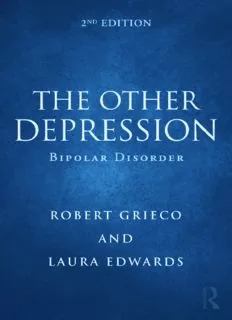Table Of Content2nd Edition
The Other
Depression
B i p o l a r D i s o rd e r
R o b e rt G r i e c o
a n d
L a u r a E d wa r d s
New York London
Routledge Routledge
Taylor & Francis Group Taylor & Francis Group
270 Madison Avenue 27 Church Road
New York, NY 10016 Hove, East Sussex BN3 2FA
© 2010 by Taylor and Francis Group, LLC
Routledge is an imprint of Taylor & Francis Group, an Informa business
This edition published in the Taylor & Francis e-Library, 2011.
To purchase your own copy of this or any of Taylor & Francis or Routledge’s
collection of thousands of eBooks please go to www.eBookstore.tandf.co.uk.
International Standard Book Number: 978-0-415-99876-5 (Hardback) 978-0-415-99877-2 (Paperback)
For permission to photocopy or use material electronically from this work, please access www.
copyright.com (http://www.copyright.com/) or contact the Copyright Clearance Center, Inc.
(CCC), 222 Rosewood Drive, Danvers, MA 01923, 978-750-8400. CCC is a not-for-profit organiza-
tion that provides licenses and registration for a variety of users. For organizations that have been
granted a photocopy license by the CCC, a separate system of payment has been arranged.
Trademark Notice: Product or corporate names may be trademarks or registered trademarks, and
are used only for identification and explanation without intent to infringe.
Library of Congress Cataloging‑in‑Publication Data
Grieco, Robert.
The other depression : bipolar disorder / by Robert Grieco, Laura Edwards.
p. cm.
Includes bibliographical references and index.
ISBN 978-0-415-99876-5 (hardback : alk. paper) -- ISBN 978-0-415-99877-2
(pbk. : alk. paper)
1. Manic-depressive illness. I. Edwards, Laura. II. Title.
RC516.G75 2009
616.89’5--dc22 2009026886
Visit the Taylor & Francis Web site at
http://www.taylorandfrancis.com
and the Routledge Web site at
http://www.routledgementalhealth.com
ISBN 0-203-86307-0 Master e-book ISBN
For my brother, Tommy Grieco
If we knew then what we know now, you would still be with us.
Contents
Foreword ix
Introduction xi
Chapter 1 Discovering Bipolar Disorder 1
Chapter 2 A Different Kind of Depression 5
Chapter 3 The Bipolar Spectrum 1 3
Chapter 4 Five Keys to the Bipolar Spectrum 1 9
Chapter 5 The Bipolar Personality 2 7
Chapter 6 Depression 33
Chapter 7 Mania 4 3
Chapter 8 Mixed States 47
Chapter 9 A Little Bit of Mania 5 1
Chapter 10 Could My Depression Be Bipolar? 5 9
Chapter 11 Associated Physical and Psychiatric Illnesses 6 7
Chapter 12 Bipolar Disorder in Children 7 9
Chapter 13 Bipolar Disorder in Adolescents 8 7
Chapter 14 Bipolar Disorder in the Elderly 9 3
Chapter 15 Seasonal Depression 97
vii
viii • Contents
Chapter 16 Suicide 101
Chapter 17 Drug Therapy for Bipolar Disorder 109
Chapter 18 Winning the Peace 125
Chapter 19 Do Antidepressants Cause Suicide? 129
Chapter 20 Bipolar Disorder and Creativity 133
Chapter 21 Too Much, Too Fast, Too Soon 137
Chapter 22 When a Loved One Has Bipolar Disorder 141
Chapter 23 Living with Bipolar Disorder 1 53
Appendix A: A Psychiatrist Speaks to Patients 1 61
SuzAnnE VOGEL-SCIBILIA, M.D.
Appendix B: A Psychiatrist Speaks to Doctors 1 71
SuzAnnE VOGEL-SCIBILIA, M.D.
Appendix C: My Patients and Their Families Speak 187
Appendix D: Five Keys to the Bipolar Spectrum 197
Appendix E: The Mood Disorder Questionnaire (MDQ) 2 01
Index 205
Foreword
It’s never as easy as they say it is. The enticement in 1987 was, “Depression
is common in primary care settings. Treating depression with antide-
pressants is straightforward and effective.” Really?
Bob Grieco and I apparently booked the same cruise to the same desti-
nation. We met each other on deck, as it were, and found ourselves telling
the same stories. We had independently stumbled onto a secret known
to the ancients and a few contemporaries in the field of psychiatry, but to
almost no one in primary care. All depressions are not the same.
After a year or two in private practice, I found using antidepressants
satisfying at times, confusing at others, and downright dangerous on
occasion. Several years after our “cruise” began, there were books: First,
Peter Kramer’s Listening to Prozac, then Peter Breggin’s Talking Back
to Prozac, and finally Breggin’s, Toxic Psychiatry. Apparently others
were catching on, too. nuevo-psychopharmacology was changing lives,
altering personalities, and in some cases making matters worse.
The lion’s share of this conundrum can be laid at the feet of undi-
agnosed bipolar disorder. It is more common than you think and
often not what you were expecting. It is less classically manic, more
depressed, angrier, and often manifested by coexisting manic and
depressed moods laced with anxiety and panic states. Bipolar disorder
is the reason you cannot put Prozac in the water supply, as was joked
about in the early 1990s. I read Kramer’s book and suspected several of
his patients’ “personality changes” on Prozac were due to antidepres-
sant-mobilized hypomania. Breggin’s analysis was overly shrill, but
correct in at least this—our over-enthusiasm around the potential for
ix
Description:In The Other Depression, Grieco and Edwards help people understand and destigmatize those afflicted with bipolar disorder. Topics discussed include the genetic signature and environmental stresses and underpinnings of this disease, along with how it alters the functioning of the brain, and how it c

